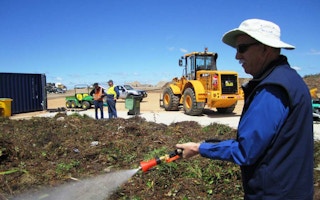It smells earthy at the Armidale dump, a mountain of rubbish built bag by bag over 50 years by the city’s 25,000 residents.
Residents say they have more than halved the amount of rubbish that ends up in red bins headed for the landfill since the introduction of the City to Soil program two years ago.
More than 70 per cent of residents are taking part in the program to turn household organic waste - ranging from potato peelings to meat scraps, used pizza boxes and lawn and garden clippings - into compost.
”When I first started here, this site had noticeably more odour, more food waste and there were many more birds and opportunistic feeders [such as rodents] looking to get a meal out of this site,” said James Turnell, Armidale and Dumaresq Council’s waste and drainage manager, as he surveyed the remaining landfill.
The program was piloted in Goulburn and Condobolin, and Armidale is the first larger regional centre to introduce it citywide.
Variations on these schemes are being tested around the world but Armidale and City to Soil are attracting international interest because of their use of incentives to get consumers involved and the low level of contamination.
Zero Waste Australia president Gerry Gillespie said most recycling programs suffered from about 15 per cent contamination, which meant farmers and gardeners did not want the end product.
In contrast, the level of contamination, such as plastics, in Armidale consumers’ green bins was about 0.5 per cent, he said.
To encourage Armidale residents, who cut council costs by sorting their rubbish at home, the rich compost is sold back to them for $25 a cubic metre (less than half the usual price) and prizes are given for the best garbage.
The compost is so popular that it is often sold out. Armidale residents talk about the ”black gold” made from the waste.
To collect the organic waste, residents were given small kitchen caddies, smell and slime-proof compostable bin liners and a 240-litre wheelie bin that is collected every fortnight. To find winners, Mr Turnell and his team lifted the lids on the green bins early one garbage day. They often award prizes in areas where they see contamination rising.
One winner was Christina Walker, who won a $50 fruit and vegetable basket. To turn the organic waste into compost, Armidale council is using static fermentation with accelerants that speed up the composting and remove odour.
A big advantage is that the program removes emission-producing waste from the landfill, Mr Turnell said.
The council estimates the program is currently diverting 3500 tonnes of organic waste from landfill per year.
Landfill is also the most expensive part of Armidale’s garbage facility because it requires heavy machinery and the costs cannot be recovered. And for councils that do not have their own landfill sites, diverting organic waste can represent a significant saving, with landfill costs ranging from $100 to more than $200 a tonne.
Mr Gillespie says the goal of the program is to divert compost generated by cities’ organic waste to the 75 per cent of Australia’s 455 million hectares of agricultural land that has less than 1 per cent organic material.










